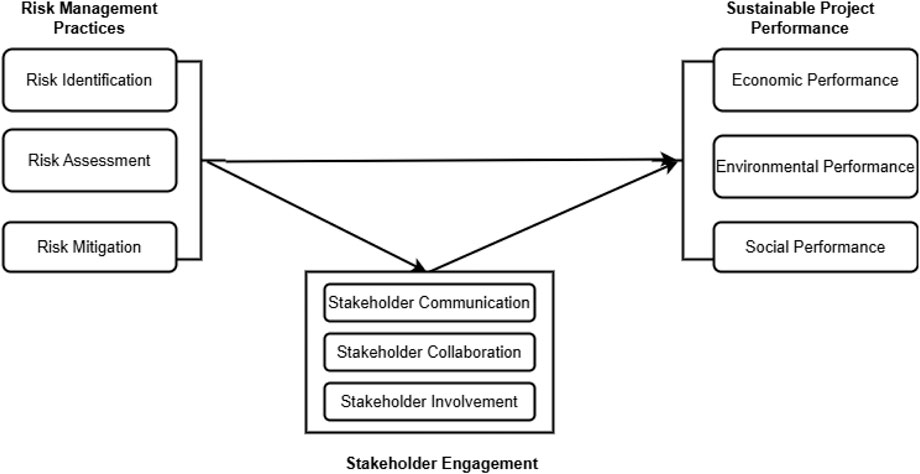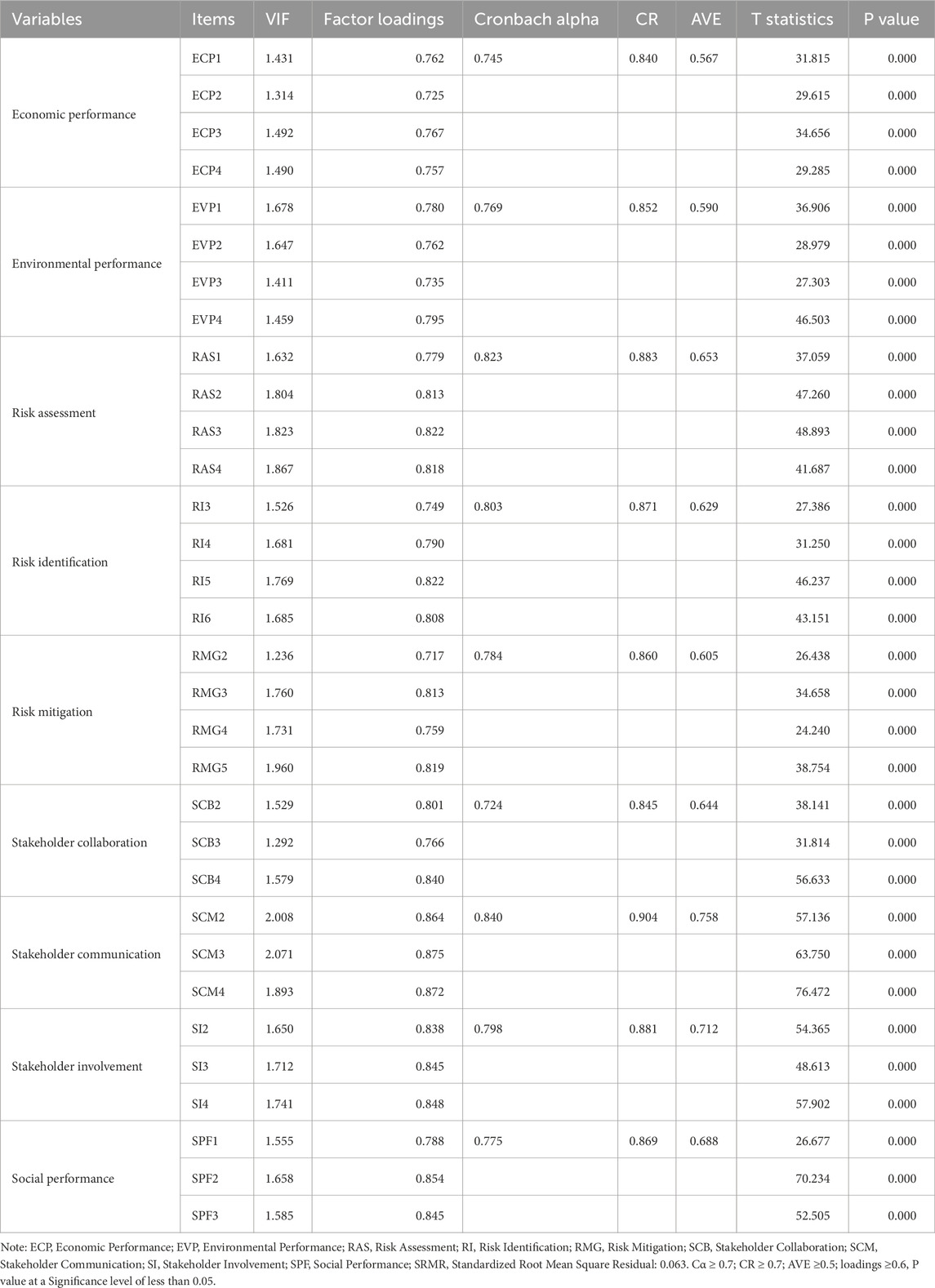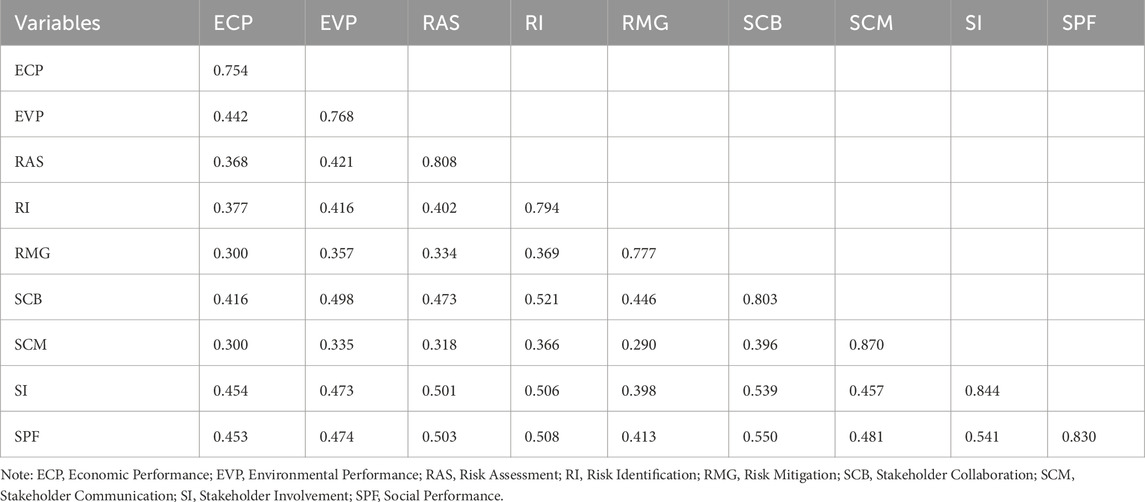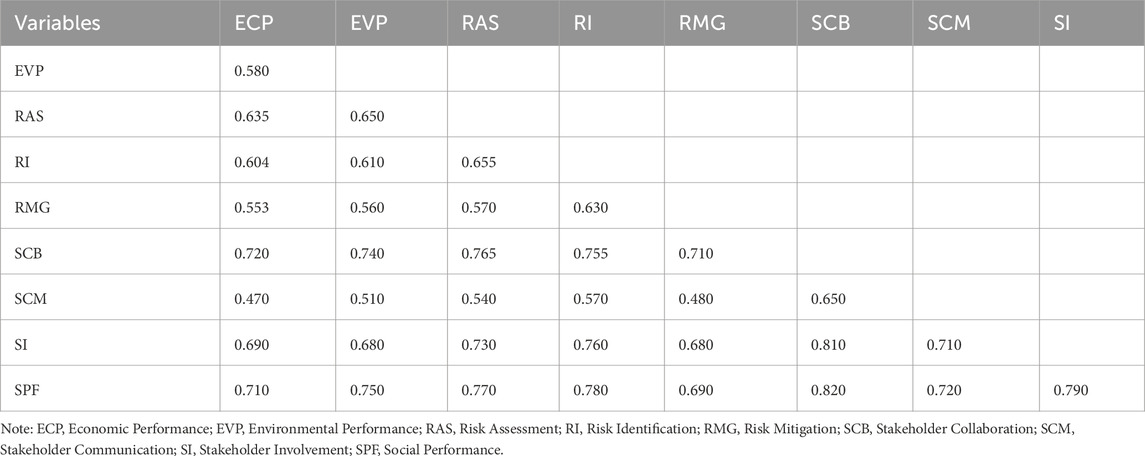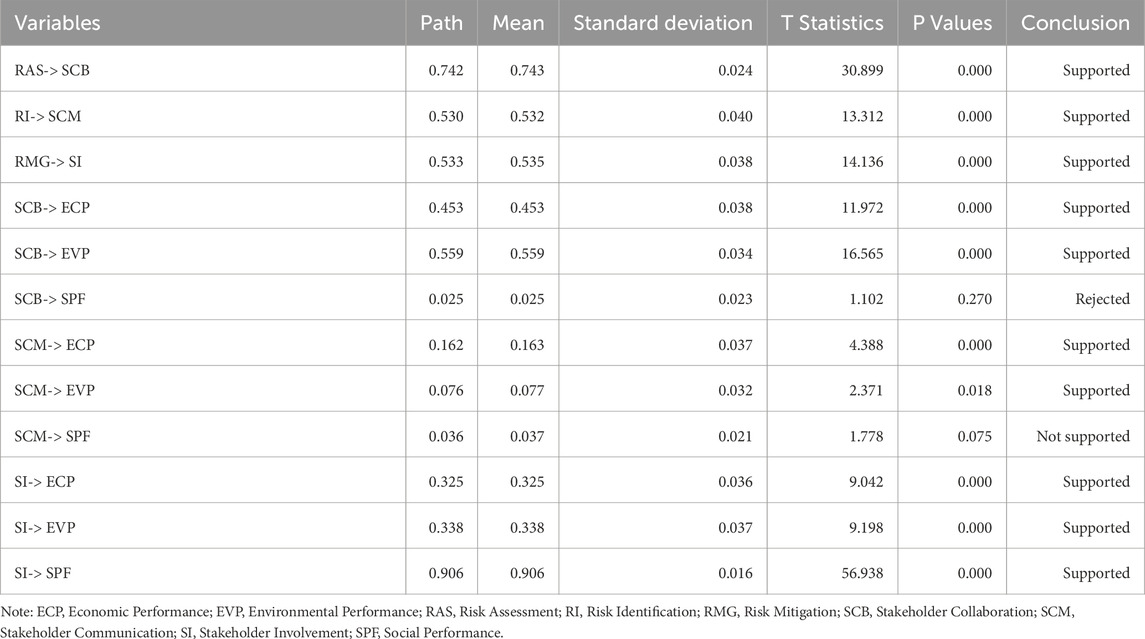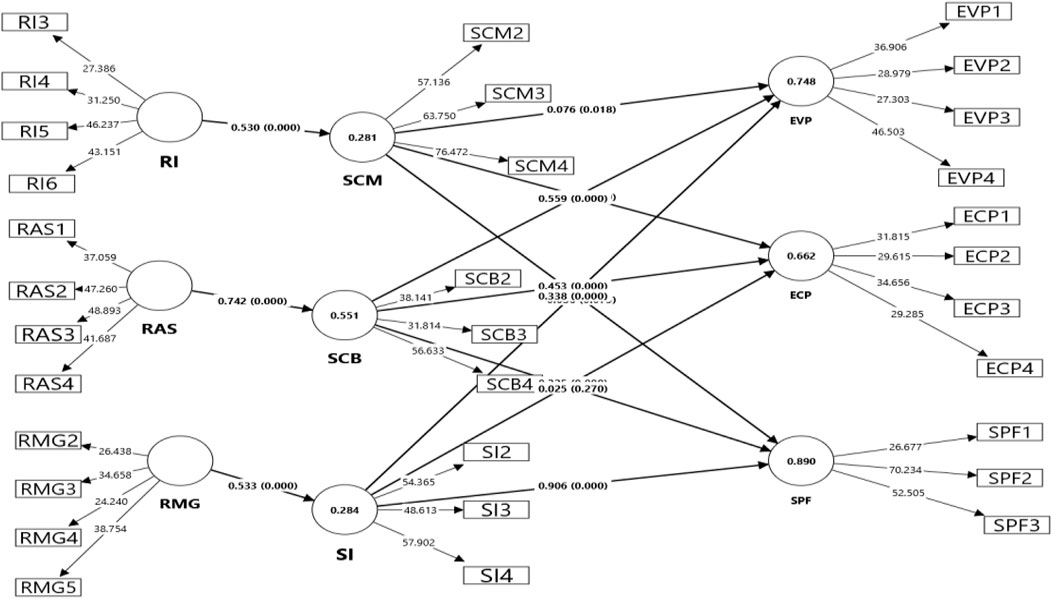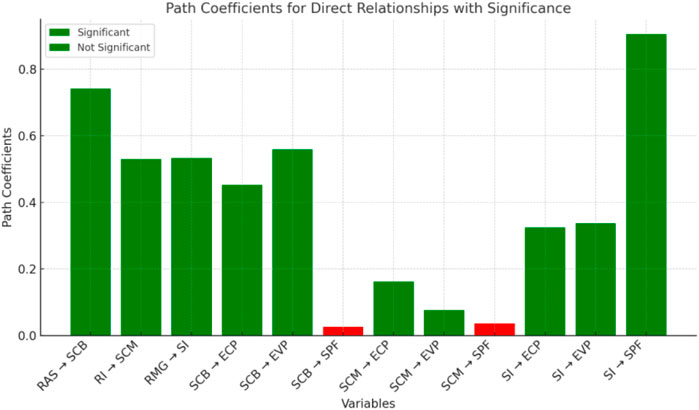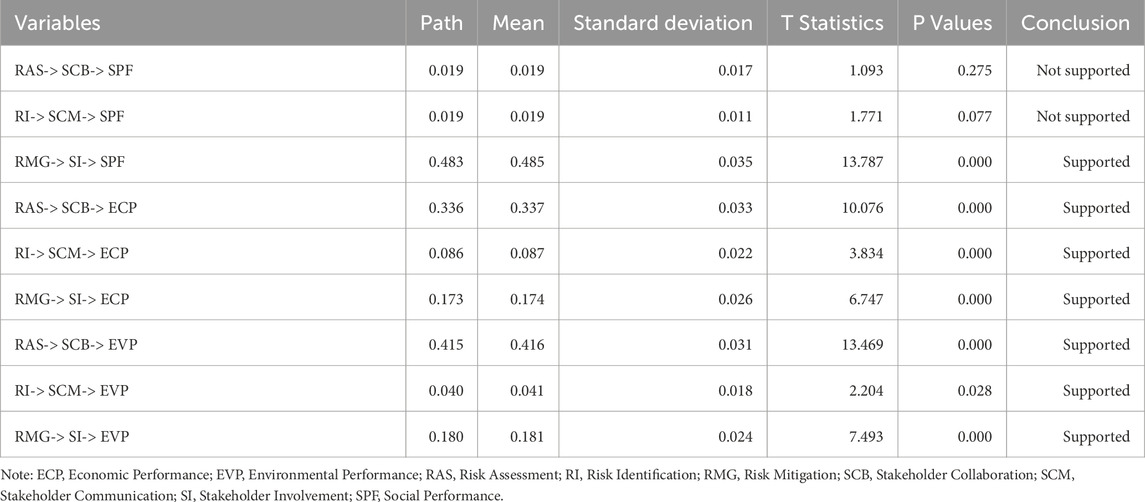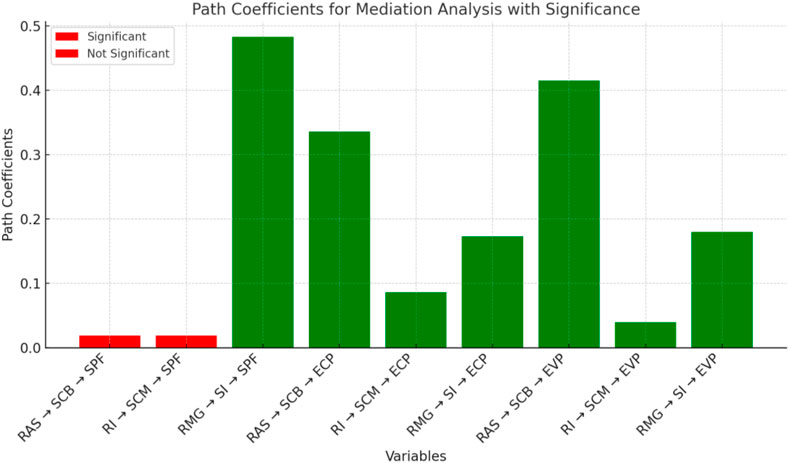- 1School of Civil Engineering, Zhengzhou University, Zhengzhou, China
- 2School of Management, Zhengzhou University, Zhengzhou, China
This study investigates the impact of risk management practices on sustainable project performance, specifically focusing on the mediating role of stakeholder engagement in the construction industry within emerging economies. It examines how risk identification, assessment, and mitigation contribute to sustainability’s environmental, economic, and social dimensions. Utilizing data collected from construction project managers involved in sustainability-driven projects, the findings confirm that all three risk management practices significantly enhance sustainable project performance. Furthermore, stakeholder engagement through communication, collaboration, and decision-making involvement plays a crucial mediating role, strengthening the effectiveness of risk management strategies in achieving sustainability goals.
1 Introduction
The growing global emphasis on sustainability has driven organizations to adopt effective risk management strategies to ensure project success and achieve long-term sustainability goals (El Khatib et al., 2020). As organizations face increasing pressures to align projects with broader economic, environmental, and social objectives, the role of risk mitigation comprising risk identification, assessment, and reduction becomes central to safeguarding project outcomes (Hollins et al., 2018). These practices are crucial in mitigating uncertainty, particularly in emerging economies, where resource limitations and infrastructure gaps often complicate project execution (Domínguez-Gómez and González-Gómez, 2021).
While the importance of risk management in project success is well established, the pathways through which these practices influence sustainable project performance, especially regarding environmental, economic, and social outcomes, remain insufficiently explored. Additionally, stakeholder engagement, which involves communication, collaboration, and decision-making, is critical in ensuring that projects align with sustainability goals (Aakhus and Bzdak, 2015). However, the literature has not adequately addressed the mechanisms through which stakeholder involvement mediates the relationship between risk management and sustainability outcomes.
Sustainable project performance is inherently multidimensional, with environmental, economic, and social outcomes often interdependent (Goel et al., 2020; Stanitsas et al., 2021). Projects incorporating effective risk management and stakeholder engagement tend to achieve better sustainability outcomes across these dimensions. Understanding how risk management practices, mediated by stakeholder engagement, contribute to these outcomes is vital for enhancing project success in resource-constrained contexts. Despite the growing literature on sustainability in project management, the relationships between risk management, stakeholder engagement, and sustainable project performance remain underexplored, particularly in emerging economies, where unique challenges such as political instability and limited infrastructure make sustainability harder to achieve (Alawneh et al., 2024; Khalifeh et al., 2020).
This research aims to address this gap by examining how risk management practices risk identification, assessment, and mitigation directly and indirectly influence sustainable project outcomes, focusing on the mediating role of stakeholder engagement. By exploring the interconnections between risk management, stakeholder involvement, and sustainable outcomes, this study will provide new insights into how these factors contribute to the resilience and sustainability of projects, particularly in emerging economies.
The research will explore two key questions: (1) How do risk management practices, including risk identification, assessment, and mitigation, influence sustainable project performance in emerging economies? and (2) How does stakeholder engagement, encompassing communication, collaboration, and involvement, mediate the relationship between risk management practices and sustainable project outcomes? The findings of this study will provide valuable insights for academics and practitioners, offering a framework for enhancing project sustainability, particularly in challenging environments.
The construction industries in Brazil, India, and South Africa face common challenges like limited resources, political instability, and regulatory changes. However, each country has unique characteristics influencing risk management and stakeholder engagement. In Brazil, the sector is shaped by government regulations and large-scale public-private projects, though bureaucratic inefficiencies and political instability remain challenges. In India, infrastructure gaps and complex regulations complicate stakeholder relationships, while rapid urbanization drives demand. South Africa’s construction sector is marked by heavy public sector involvement, with socio-political factors like labor strikes and land reform efforts playing a significant role. These institutional differences highlight the importance of tailored risk management and stakeholder strategies for successful construction projects in each country.
The paper is organized as follows: Section 1 introduces the research objectives, questions, and significance. Section 2 reviews key concepts in risk management, stakeholder engagement, and sustainable project performance. Section 3 details the research methodology, including data collection, sampling, and analysis techniques. Section 4 presents the results, including descriptive statistics, model validation, and SEM findings. Finally, Section 5 discusses the study’s findings, draws conclusions, and provides recommendations for future research and practice.
2 Literature review
The growing emphasis on sustainability in project management has stimulated research on how managing risks can enhance sustainable project performance. As global pressures increase to meet environmental, social, and economic objectives, it is crucial for projects to not only meet immediate deliverables but also align with long-term sustainability goals (Kaiser and Schulz, 2020). In this context, effective risk management practices comprising risk identification, risk assessment, and risk mitigation are fundamental to achieving sustainability objectives. These practices aim to minimize uncertainties, increase resilience, and ensure that projects remain adaptable to evolving environmental and societal needs (Domínguez-Gómez and González-Gómez, 2021).
Recent studies emphasize the evolving role of technology and data analytics in improving risk management and sustainability. For example, Tambwe et al. (2025) highlight the benefits of construction data risk management in enhancing operational efficiency and sustainability outcomes in the construction industry. By leveraging advanced data analytics, construction projects can better anticipate and mitigate risks that could hinder achieving sustainability goals. Similarly, Purushothaman et al. (2025) explore how smart technologies influence construction health and safety risk reduction, demonstrating their potential to enhance sustainability in a digital era. These studies underscore the importance of integrating technology into risk management to achieve more sustainable outcomes.
Despite the growing body of literature on risk management in project success, the specific mechanisms through which these practices influence sustainable project performance, particularly in emerging economies, remain less explored (Turner, 2020). Emerging economies face unique challenges, such as limited resource access, infrastructure gaps, and governance issues, which complicate project execution and sustainability (Alawneh et al., 2024). This gap in the literature highlights the need for studies that explore how stakeholder engagement mediates the relationship between risk management practices and sustainable project outcomes, particularly in these resource-constrained settings.
In line with this, Alsulamy (2025) explores the role of machine learning models such as CatBoost, XGBoost, and LGBM in predicting and mitigating risks associated with project delays in Saudi Arabia. This innovative approach demonstrates the potential for advanced technologies to predict and manage risks in real-time, enhancing sustainability in construction projects. Thus, while the connection between risk management and project success is well-documented, understanding the intermediary role of stakeholder engagement in mediating the effects of risk management on sustainable project performance remains underexplored. Further research in this area, particularly in emerging economies, is essential to provide a more comprehensive understanding of how these practices can be effectively integrated to drive long-term sustainability.
2.1 Risk management practices and sustainable project performance
Risk management is foundational in managing the uncertainties that often arise during project execution. It takes a methodical strategy for recognizing possible dangers, assessing their probability and impact, and executing suitable actions for their mitigation (Irfan et al., 2024). The processes of identification of risks, assessment of risks, and reduction of risks are critical in determining whether a project will achieve sustainable outcomes. Risk identification allows project managers to proactively detect risks that could jeopardize the project’s environmental, economic, or social sustainability goals, such as environmental degradation or cost overruns. Early detection of these risks enables more informed decision-making and better preparedness (Kaiser and Schulz, 2020). Similarly, risk assessment is integral to evaluating the likelihood and consequences of these risks, providing a basis for resource allocation and risk response strategies (Turner, 2020). Lastly, risk mitigation strategies aim to reduce or eliminate the potential impacts of identified risks, thereby ensuring the goal does not lose focus on meeting its sustainability objectives (Domínguez-Gómez and González-Gómez, 2021).
While existing research underscores the viability of mitigating risks in attaining project success., empirical studies specifically linking risk management practices to resilient delivery of projects remain scarce, especially in emerging economies that face unique resource and governance challenges (Armitage et al., 2017). However, several studies suggest that risk management practices can influence sustainability outcomes across three main dimensions: environmental, economic, and social. Risk identification allows for anticipating environmental hazards and potential disruptions, facilitating proactive actions to mitigate these risks and optimizing environmental performance (Almeida et al., 2021). Risk assessment helps allocate resources more efficiently, improving economic performance by reducing cost-related risks such as delays, waste, and underutilized resources. Risk mitigation, in turn, plays a pivotal role in augmenting societal sustainability by addressing potential social impacts such as community displacement or labour exploitation (Domínguez-Gómez and González-Gómez, 2021).
H1a: Risk identification produces a constructive effect on sustainable project performance.
H1b: Risk assessment produces a constructive effect on sustainable project performance.
H1c: Risk mitigation produces a constructive effect on sustainable project performance.
Empirical studies support the idea that mitigation of risk practices directly affects sustainable project performance. For instance, risk identification enhances environmental sustainability by recognizing and alleviating potential environmental risks early in the project lifecycle (Kaiser and Schulz, 2020). Similarly, risk assessment is linked to economic sustainability since it facilitates enhanced financial planning and resource management, thereby reducing financial risks and ensuring the efficient use of resources (Turner, 2020). Lastly, risk mitigation enhances social sustainability by ensuring that social issues are addressed, stakeholders’ concerns are considered, and the project remains socially acceptable (Domínguez-Gómez and González-Gómez, 2021).
2.2 Stakeholder engagement as a mediator
Stakeholder engagement is crucial for the accomplishment of projects, especially when aiming for sustainability goals. Effective stakeholder engagement involves various activities such as stakeholder correspondence, cooperation, and strategic planning involvement. Stakeholder communication involves providing stakeholders with prompt and reliable data, thus fostering integrity and credibility (Haar, 2024). Stakeholder collaboration refers to the active cooperation of stakeholders in addressing project challenges and optimizing solutions. In contrast, stakeholder involvement in decision-making ensures that all relevant perspectives are considered and included in the project’s strategies (Berkhout and Dow, 2023; Isang et al., 2025).
The findings suggest that the involvement of stakeholders mediates the link between risk mitigation practices and sustainable outcomes of goals. Risk mitigation identifies and mitigates potential dangers, while stakeholder involvement provides alignment with the benchmark’s sustainability goals, facilitating the execution of these measures. By engaging entities in the resolution formulation, risk management strategies may be effectively implemented, leading to improved project outcomes. In this context, stakeholder engagement is a critical link between risk mitigation strategies and achieving sustainability objectives, particularly in emerging economies, where stakeholder interests may be more diverse and complex (Eyieyien et al., 2024).
H2a: Risk identification positively affects stakeholder engagement.
H2b: Risk assessment positively affects stakeholder engagement.
H2c: Risk mitigation positively affects stakeholder engagement.
Empirical research supports the idea that risk mitigation strategies significantly influence the level and quality of stakeholder engagement. For example, risk identification facilitates stakeholder communication, as it necessitates sharing information about potential risks and the measures to mitigate them (Barko et al., 2022). Similarly, risk assessment encourages stakeholder collaboration by involving stakeholders in reducing the possibility of potential risks, thus fostering cooperation (Frączkiewicz-Wronka et al., 2021). Risk mitigation, in turn, often requires stakeholder involvement in decision-making to ensure that strategies are effectively implemented and every relevant entity is in sync with the sustainability objectives (Domínguez-Gómez and González-Gómez, 2021).
2.3 Stakeholder engagement and sustainable project performance
The direct impact of the involvement of entities on sustainable objectives has been demonstrated. Strategic involvement of entities can enhance environmental performance by ensuring that environmental concerns are included in all project phases (Jung, 2022; Wu et al., 2023). Stakeholder collaboration, in particular, has been linked to economic performance through efficient resource use, knowledge sharing, and innovative solutions to address cost-related issues. Furthermore, stakeholder involvement in decision-making has a massive role in bettering social effectiveness by ensuring that social issues, such as community welfare and labour rights, are prioritized and addressed (Al-Nimer et al., 2024; Zada et al., 2024).
Empirical evidence consistently demonstrates the favourable outcome on stakeholder engagement in all areas of sustainable project performance. For example, stakeholder communication has been shown to foster greater environmental sustainability by ensuring compliance with environmental standards and regulations. Similarly, stakeholder collaboration enhances economic sustainability by reducing costs and improving efficiency (Alghuried, 2025; Jung, 2022). Finally, stakeholder involvement in decision-making is crucial for social sustainability, as it guarantees that communal requirements and expectations are met, leading to improved stakeholder satisfaction and reduced social risks (Isang et al., 2025; Zada et al., 2024).
H3a: Stakeholder communication positively affects sustainable project performance.
H3b: Stakeholder collaboration positively affects sustainable project performance.
H3c: Stakeholder involvement positively affects effective project performance.
2.4 The mediating role of stakeholder engagement
The role of stakeholder engagement as a mediator between risk management practices and the sustainable effectiveness of projects is central to understanding how these constructs interact. Risk management practices are crucial for noticing and mitigating risks, but their success often depends on how effectively stakeholders are engaged throughout the project lifecycle. Research has proven that stakeholder engagement facilitates the enforcement of risk management strategies, particularly by ensuring all entities are included in the decision-making process (Aakhus and Bzdak, 2015). As a result, stakeholder engagement enhances the effectiveness of risk management practices, leading to better environmental, economic, and social sustainability outcomes.
H4a: Stakeholder engagement has a productive impact on environmental performance.
H4b: Stakeholder engagement has a productive impact on economic performance.
H4c: Stakeholder engagement has a productive impact on social performance.
Empirical research consistently shows that stakeholder engagement improves sustainable project performance across all three dimensions. For example, stakeholder communication is linked to better environmental outcomes by fostering a shared understanding of environmental risks and compliance requirements. Similarly, stakeholder collaboration enhances economic performance by improving resource utilization and reducing costs (Jung, 2022). Finally, stakeholder involvement in decision-making improves social sustainability by ensuring that the concerns of affected communities are addressed (Zada et al., 2024).
This literature review has comprehensively analyzed the correlations between risk mitigation strategies and sustainable goal performance. It has highlighted the importance of risk management practices in enhancing project sustainability. It has demonstrated stakeholder engagement’s critical role in mediating the relationship between risk management and sustainable outcomes. The research has also brought out key gaps in the scholarly works, particularly concerning the mediating role of stakeholder engagement in emerging economies. By addressing these gaps, this research provides important recommendations on how risk mitigation strategies can contribute to sustainable project performance when combined with effective stakeholder engagement. The results will enhance theoretical development and practical suggestions for managing sustainable projects in complex and resource-constrained environments. Figure 1 below depicts the framework of the study.
3 Methods
3.1 Research design
This research adopted a quantitative research framework. This framework was appropriate for understanding the relationships between variables and testing the proposed hypotheses in a specific context (Cresswell et al., 2018). The study focused on how the strategies used to mitigate and manage risks influenced sustainable project performance in emerging economies through stakeholder engagement as a mediator. The quantitative approach enabled the study to test predefined hypotheses using Statistical techniques, including confirmatory factor analysis (CFA) and structural equation modelling (SEM), to evaluate the direct and indirect correlations among the variables. The research employed deductive reasoning, where hypotheses derived from the existing literature were tested. Confirmatory factor analysis (CFA) was used to validate the measurement model initially, and structural equation modelling (SEM) was subsequently used to test the structural model that linked the hypothesized relationships between risk management, stakeholder engagement, and sustainable project performance (Hair et al., 2019). SEM allowed for examining multiple relationships simultaneously, which was essential for understanding how stakeholder engagement mediated the effects of risk management on sustainability outcomes.
3.2 Population and sampling
The population for this study consisted of strategic planners and key stakeholders who have taken part in infrastructure projects in emerging economies, specifically targeting regions such as India, Brazil, and South Africa. These countries face specific governance, resources, and infrastructure challenges, making them ideal contexts for this study. The research focused on public and private sector entities, where the stakes for sustainability are high, and risk management and stakeholder engagement are critical for success. A stratified random sampling method was employed to ensure that diverse operations (e.g., construction, infrastructure, energy) and stakeholders (e.g., strategic planners, vendors, civil servants, and citizen delegates) were adequately represented in the sample. The stratified sampling technique was essential to ensure the sample reflected the diversity of projects and stakeholder groups involved in the research (Kennedy, 2022).
3.3 Data collection approach
The data for this research were collected using a self-administered digital questionnaire. This method was selected because of its efficiency and accessibility, especially considering the widespread geographic distribution of the target population across emerging economies. An online survey effectively reached various respondents, including strategic planners, managers, contractors, stakeholders, and government officials, each of whom plays an important role in understanding risk mitigation strategies, stakeholder engagement, and sustainable project performance.
To ensure a representative sample, we initially contacted 800 potential respondents across Brazil, India, and South Africa. These respondents were reached through direct emails, industry forums, and personal networks within the construction sector. After follow-up rounds, we received 545 valid responses, representing a diverse range of stakeholders involved in construction, infrastructure, and energy sectors.
The stratified random sampling method was employed to ensure a representative sample. The distribution of respondents was proportionally allocated based on the size and sectoral importance of the construction industry in each country. Specifically, Brazil accounted for 40% of the respondents, India for 35%, and South Africa for 25%. This ensured that the sample adequately represented the different sectors and stakeholder groups involved in the construction industry across these three emerging economies.
The survey was structured into segments aligned with the study’s key constructs: risk management practices, stakeholder engagement, and long-lasting project performance. The questionnaire included validated items from established scales to ensure reliability and validity. Questions for the risk management protocols section covered risk identification, risk assessment, and risk mitigation, adapted from previous studies (Turner, 2020). The stakeholder engagement section measured dimensions such as communication, collaboration, and involvement in decision-making using items adapted from (Haar, 2024). The sustainable project performance section assessed environmental, economic, and social performance, following frameworks from Zada et al. (2024), Haar (2024).
The survey instrument was first pre-tested on a small sample of 30–40 participants to clarify the effective capture of the intended constructs. Responses from this pre-test were used to refine the questionnaire before full-scale distribution. Afterwards, the survey was dispatched to a larger sample of professionals involved in construction, infrastructure, and energy projects in emerging economies. The target sample size for this study was 545 respondents, ensuring that the data collected was robust enough to detect meaningful patterns and relationships. To ensure clarity in the measurement of the constructs in this study, we have provided a detailed list of the manifest variables used to assess each latent variable in the theoretical model, as shown in Supplementary Appendix 1. Each manifest variable is linked to its respective construct, with clear descriptions of what each item represents and how it contributes to understanding the broader construct. This table serves to provide transparency in how the variables were operationalized, ensuring that the readers can follow the theoretical and empirical reasoning behind the measurement choices made in this study. The poll was disseminated through email and online media. Such as industry forums, where participants were informed of the study’s purpose, and their informed consent was obtained before they began the survey. They were also assured that their responses remained confidential and anonymous, with the data used solely for research purposes.
3.4 Data analysis
The data analysis for this study utilized Structural Equation Modeling (SEM) to test the relationships between risk management practices, stakeholder engagement, and sustainable project performance. SEM is ideal for examining intricate connections involving direct and indirect effects and is widely used for model testing in management research (Hair et al., 2019). The initial stage involved Confirmatory Factor Analysis (CFA) to confirm the evaluation framework’s accuracy, ensuring that the observed variables effectively represent the underlying latent constructs such as risk management practices, stakeholder engagement, and sustainable project performance. CFA allowed researchers to analyze the extent to which the objects represented their respective constructs and were particularly useful for testing construct validity (McGrath, 2023).
Once the evaluation framework was validated, SEM was introduced to analyze the hypothesized structural relationships between the constructs. Maximum Likelihood Estimation (MLE) was employed for parameter estimation, as MLE is a widely used method in SEM that provides efficient and consistent estimates under normality (Adu Sarfo et al., 2024; Hair et al., 2019). The framework examined the direct effects of risk management practices (risk identification, risk assessment, and risk mitigation) on sustainable project performance and the indirect effects through stakeholder engagement. This approach helped determine whether stakeholder engagement mediated the link between risk mitigation strategies and sustainability outcomes, including environmental, economic, and social dimensions (Kukah et al., 2024).
Bootstrapping was applied to evaluate the importance of the indirect effects. Bootstrapping is a non-parametric resampling technique that is robust and effective for testing mediation models, mainly when sample sizes are small or the data deviates from normality (Hayes and Preacher, 2014). Bootstrapping generated confidence intervals for the indirect effects, and whether the confidence intervals excluded zero indicated that the mediation effect was statistically significant. This method has been increasingly favoured in recent research due to its ability to provide more reliable estimates of the effects of mediation than traditional methods (Hayes and Preacher, 2014).
In addition to testing the relationships, this research evaluated the reliability and validity of the measurement instruments. Cronbach’s alpha was used to analyze the dependability of the constructs, with a threshold of 0.70 or higher considered acceptable (Kennedy, 2022). Discriminant validity was tested using the Fornell-Larcker criterion, ensuring the framework’s constructs differed (Fornell and Larcker, 1981). These tests confirmed that the instruments employed to assess the structures were both reliable and valid.
3.5 Ethical considerations
Ethical considerations were a top priority in this study. All participants provided informed consent after clearly explaining the study’s objectives, the voluntary nature of their involvement, and the intended use of their data. Anonymity and confidentiality were assured, and no personally identifiable information was collected. Before data collection, ethical approval was secured from the university’s institutional review board (IRB) to ensure compliance with ethical standards.
4 Results
This study analyses the correlations among risk management methods, stakeholder involvement, and sustainable project performance in emerging economies. The investigation utilized Structural Equation Modelling (SEM) to evaluate the direct and indirect correlations among the variables, while Confirmatory Factor investigation (CFA) was employed to validate the measurement model. The research examined the impact of risk management methods on sustainable project performance by mediating stakeholder engagement. Mediation analysis employing bootstrapping was utilized to examine the indirect impacts, offering an in-depth investigation of the mechanisms connecting risk management methods to sustainability outcomes (Hair et al., 2019).
4.1 Descriptive statistics
The census data of the sample are presented in Figure 2. A total of 545 respondents took part in this research, with a slightly higher proportion of female respondents (55.3%) than males (44.7%). The age distribution of respondents was diverse, with 30.8% of the respondents in the 25–34 age group, followed by 29.4% in the 35–44 group. Regarding education, most participants held either a Bachelor’s (41.2%) or a Master’s degree (42.2%), and 42.2% had 0–5 years of professional industry expertise. The majority of respondents were involved in the construction industry (28.1%), followed by energy (27.2%) and infrastructure (26.1%). Respondents were primarily Project Managers (36.1%), followed by contractors (29%) and stakeholders (19.6%).
4.2 Measurement model validation
The Confirmatory Factor Analysis (CFA) results indicated a good fit for the measurement model, with the factor loadings for all constructs exceeding the threshold of 0.70 (Table 1). Cronbach’s Alpha values ranged from 0.724 to 0.860, which indicates strong internal consistency (Kennedy, 2022). The Composite Reliability (CR) values were also above 0.70, supporting the reliability of the constructs (Hair et al., 2019). The Average Variance Extracted (AVE) values ranged from 0.605 to 0.758, all exceeding the threshold of 0.50, which confirmed convergent validity. The SRMR value (0.063) was under the acceptable range of 0.08, proving a good model fit. The T-statistic is used to determine whether the coefficients significantly differ from zero. A T-statistic greater than 1.96 is considered significant. P-values less than 0.05 indicate statistical significance. The outcome demonstrates that the framework is valid and reliable for testing the hypothesized relationships (Rose and Johnson, 2020).
4.3 Reliability and validity assessment
The reliability of the constructs was confirmed by Cronbach’s alpha values, which were all above the acceptable threshold of 0.70, indicating good internal consistency across the constructs (Forero, 2024). The discriminant validity was tested using the Fornell-Larcker criterion (Table 2), which showed that all constructs were distinct, as the square root of AVE for each construct was greater than its correlations with other constructs (Fornell and Larcker, 1981). Additionally, the Heterotrait-Monotrait (HTMT) ratio (Table 3) was below the threshold of 0.85, further confirming that the constructs were adequately distinct from one another (Hair et al., 2019).
4.4 Model fit and predictive relevance
The model’s fit was evaluated for goodness-of-fit indices such as SRMR, with figures below 0.08 proving a good fit. The R-squared (R2) values for the constructs were generally strong, with ECP (0.748) and EVP (0.783) showing high explanatory power. SCB (0.688) and SCM (0.715) had moderate fits, while SI (0.763) and SPF (0.855) demonstrated good to excellent fits. Q2 values indicated good predictive relevance across all constructs, ranging from 0.473 to 0.610. AVE values were above 0.500, and construct reliability (CR) exceeded 0.700, showing that the framework was reliable and valid (Fornell and Larcker, 1981).
4.5 Structural model results
The Structural Equation Modeling (SEM) results in Table 4 and Figure 3 revealed viable links between the constructs. Risk assessment (RAS) had a positive effect on stakeholder collaboration (SCB) (β = 0.742, p < 0.001) (Turner, 2020). Risk identification (RI) positively influenced stakeholder communication (SCM) (β = 0.530, p < 0.001), and risk mitigation (RMG) had a positive effect on stakeholder involvement (SI) (β = 0.533, p < 0.001) (Domínguez-Gómez and González-Gómez, 2021). Moreover, stakeholder collaboration (SCB) had a significant impact on economic performance (ECP) (β = 0.453, p < 0.001) and environmental performance (EVP) (β = 0.559, p < 0.001) but no effect on social performance (SPF) (β = 0.025, p = 0.270). Stakeholder communication (SCM) positively influenced economic performance (ECP) (β = 0.162, p < 0.001) and environmental performance (EVP) (β = 0.076, p = 0.018) but did not significantly affect social performance (SPF) (β = 0.036, p = 0.075) (Berkhout and Dow, 2023). Stakeholder involvement (SI) had a significant positive effect on all three dimensions of sustainable project performance, with β values of 0.325, 0.338, and 0.906 for ECP, EVP, and SPF, respectively, all with p-values less than 0.001 (Zada et al., 2024). Figure 4 displays the path coefficients for the direct relationships analyzed in the study. The paths with statistically significant relationships (p < 0.05), such as RAS → SCB, RI → SCM, and SI → SPF, are represented in green, highlighting their positive impact on sustainable project performance. In contrast, paths with p-values above 0.05 (e.g., SCB → SPF) are marked in red, indicating that these relationships were not statistically significant. This visual representation reinforces the importance of focusing on significant paths to ensure that risk management practices contribute effectively to achieving sustainability objectives in project management.
4.6 Mediation analysis
A mediation analysis was conducted to examine the indirect effects of stakeholder engagement on the relationship between risk management practices and sustainable project performance. The bootstrapping results (Table 5; Figure 5) revealed that stakeholder involvement (SI) mediated the relationship between risk mitigation (RMG) and social performance (SPF), with an indirect effect (β = 0.483, p < 0.001) (Zhao et al., 2024). However, other indirect relationships, such as risk assessment (RAS) →, stakeholder collaboration (SCB) → social performance (SPF), and risk identification (RI) → stakeholder communication (SCM) → social performance (SPF), were not supported, as their p-values were greater than 0.05 (i.e., p = 0.275 and p = 0.077, respectively). This shows that stakeholder involvement is critical in mediating the effects of risk management on social sustainability. In contrast, other forms of stakeholder engagement do not show significant mediation effects in this context.
4.7 Summary of results
The study’s results robustly endorse the direct and indirect correlations among risk management approaches, stakeholder involvement, and sustainable project performance. Risk management approaches, specifically risk identification, assessment, and mitigation, profoundly impacted stakeholder engagement. Consequently, stakeholder participation enhanced sustainable project performance in environmental, economic, and social aspects. The mediation study indicated that stakeholder involvement mediated the connection between risk mitigation and social performance, whereas other mediation pathways were not substantiated.
5 Discussions
This study offers valuable insights into the relationship between risk management practices and sustainable project performance, particularly in emerging economies. Our findings indicate that risk identification, assessment, and mitigation positively influence sustainable project outcomes, with stakeholder engagement as a critical mediator in these interactions. Risk identification significantly enhances sustainable project performance, especially in the environmental dimension. This aligns with Kaiser and Schulz (2020), who highlight that early identification of environmental risks allows for proactive actions that can mitigate potential environmental damage. In addition to minimizing risks, effective risk identification fosters stakeholder communication, which is crucial for ensuring that the project remains aligned with sustainability goals.
Risk assessment also plays a vital role in sustainable project performance, especially from an economic perspective. Our findings support Turner (2020) and Berkhout and Dow (2023), who underscore the role of risk assessment in resource allocation and financial planning. Project managers can optimize resource use, reduce costs, and improve economic outcomes by evaluating potential risks, especially financial constraints. Moreover, risk assessment promotes stakeholder collaboration, as stakeholders work together to reduce the likelihood and impact of identified risks. Risk mitigation, particularly in the social dimension, further supports sustainable project performance. Our findings corroborate the work of Domínguez-Gómez and González-Gómez (2021), showing that effective mitigation strategies help manage social impacts such as community displacement or labour exploitation. Risk mitigation enhances stakeholder involvement in decision-making, leading to more effective strategy implementation, greater project acceptance, and reduced social risks.
A significant contribution of this study is identifying stakeholder engagement as a mediator between risk management practices and sustainable project outcomes. While risk management strategies are essential, their effectiveness is maximized when stakeholders are involved throughout the project lifecycle. This finding aligns with Aakhus and Bzdak (2015), emphasizing that stakeholder participation ensures alignment with the project’s sustainability objectives, enhancing overall effectiveness. In emerging economies, where stakeholder interests can be diverse and complex, effective stakeholder engagement becomes even more crucial to avoid delays and project failures.
Moreover, our results reveal the synergistic role of stakeholder collaboration and communication in promoting environmental and economic sustainability. While previous research often treats these dimensions separately, our study suggests that stakeholder collaboration can lead to innovative solutions that simultaneously reduce environmental risks and improve resource efficiency, leading to better cost management.
5.1 Conclusions
This research provides strong evidence for the positive impact of risk management practices on sustainable project performance, with stakeholder engagement playing a key mediating role. The study’s findings contribute to the growing body of knowledge on sustainability in project management by emphasizing the importance of risk identification, assessment, and mitigation in achieving environmental, economic, and social sustainability goals.
The key takeaway from this study is that stakeholder participation is essential for maximizing the effectiveness of risk management practices, ensuring that sustainability objectives are met throughout the project lifecycle. By involving stakeholders in communication, collaboration, and decision-making, projects are more likely to achieve sustainable outcomes, especially in resource-constrained emerging economies.
Our research suggests that future studies should further explore how different forms of stakeholder engagement, such as communication, collaboration, and involvement, can be leveraged to tackle sustainability challenges more effectively. As sustainability goals continue to evolve, this study provides practical insights for improving project management practices, ensuring that projects are successful in the short term and contribute to long-term sustainable development.
5.2 Theoretical implications
This research contributes to the expanding body of knowledge on the intersection of risk management practices and sustainable project performance, particularly within the construction industry in emerging economies. The findings emphasize that risk identification, assessment, and mitigation are fundamental to achieving sustainable construction project outcomes across environmental, economic, and social dimensions. Theoretically, this study supports and extends prior research by Kaiser and Schulz (2020), demonstrating that each risk management practice significantly enhances sustainable project performance. These findings align with perspectives presented by Irfan et al. (2024) and Domínguez-Gómez and González-Gómez (2021), who emphasize the importance of structured risk management frameworks in ensuring project resilience and sustainability in the construction sector.
Furthermore, this study advances theoretical understanding by establishing the mediating role of stakeholder engagement in the risk management-sustainability nexus. The results illustrate that stakeholder communication, collaboration, and decision-making involvement not only facilitate the implementation of risk management strategies but also amplify their impact on sustainability objectives. This enhances existing frameworks, such as the work of Eyieyien et al. (2024), by reinforcing that stakeholder engagement is not merely a supporting element but a crucial mediator in construction project success. By emphasizing this interdependence, the study provides a refined theoretical model that illustrates how risk management and stakeholder participation work synergistically to enhance project performance, particularly in high-risk construction environments.
Additionally, this research contributes to the theoretical discourse on the context-specific nature of sustainability in construction projects within emerging economies. Armitage et al. (2017) noted that the governance structures, resource constraints, and socio-political environments in these regions require re-evaluating traditional risk management models. Our findings suggest that integrating stakeholder engagement within risk management strategies is critical for ensuring construction projects remain both resilient and sustainable. This theoretical advancement underscores the necessity of adaptive risk management approaches in the construction industry, particularly in markets where regulatory shifts, financial instability, and environmental risks are prevalent. By bridging these theoretical gaps, this study provides a comprehensive framework for understanding how risk management practices and stakeholder engagement collectively drive sustainability outcomes in the construction sector. It lays the foundation for future research to explore industry-specific risk dynamics and stakeholder strategies that enhance project efficiency and resilience.
5.3 Practical implications
The findings of this research have several critical implications for construction project managers, policymakers, and organizations involved in sustainable project management. The study underscores the importance of adopting comprehensive risk management practices, particularly risk identification, assessment, and mitigation, as essential components of sustainability strategies in construction projects. Project managers can leverage these practices to proactively address potential environmental, economic, and social risks, ensuring that sustainability benchmarks are met while enhancing project resilience.
For construction practitioners, especially in emerging economies where resource constraints are prevalent, this study highlights the necessity of early risk identification to mitigate environmental degradation, cost overruns, and project delays. Implementing structured risk management approaches enables better resource allocation, minimizes unexpected disruptions, and ensures projects are delivered on time and within budget. The study’s findings also emphasize that a strong correlation exists between risk assessment and economic performance, suggesting that construction managers should focus on developing robust risk models to predict financial uncertainties, optimize budgeting, and prevent cost escalations.
Additionally, this study identifies stakeholder engagement as a critical component in implementing risk management strategies in construction projects. Effective communication, collaboration, and stakeholder involvement in decision-making are pivotal in achieving sustainability objectives. This is particularly crucial in large-scale construction projects, where local communities, governmental agencies, investors, and environmental groups often have competing interests. By fostering transparent communication and participatory decision-making, construction project managers can enhance stakeholder trust, minimize conflicts, and ensure regulatory compliance, all essential for long-term project sustainability.
In practical terms, this study advocates for integrating stakeholder engagement within risk management frameworks to strengthen project sustainability in the construction sector. Policymakers and construction firms should prioritize mechanisms aligning these interests with sustainability goals in regions where diverse stakeholder interests often lead to disputes or delays. Strategies such as stakeholder workshops, regular project updates, and collaborative decision-making forums can significantly enhance stakeholder buy-in and project feasibility. The construction industry can effectively navigate risk complexities by adopting these approaches while promoting sustainable development.
5.4 Limitations and further research exploration
The research findings are limited by the concentration on a particular set of projects in a specific region, which may not be generalizable to other industries or areas. Future research could expand the scope to examine different sectors and geographical areas. Additionally, while the research focused on core risk management practices (identification, assessment, and mitigation), other strategies like risk transfer and monitoring were not considered, and their impact on sustainability could be explored.
Data availability statement
Publicly available datasets were analyzed in this study. This data can be found here: https://doi.org/10.6084/m9.figshare.28331318.v1.
Author contributions
JS: Writing – original draft, Funding acquisition, Supervision. MM: Writing – review and editing. PA: Data curation, Formal Analysis, Methodology, Writing – original draft.
Funding
The author(s) declare that no financial support was received for the research and/or publication of this article.
Conflict of interest
The authors declare that the research was conducted in the absence of any commercial or financial relationships that could be construed as a potential conflict of interest.
Generative AI statement
The authors declare that no Generative AI was used in the creation of this manuscript.
Publisher’s note
All claims expressed in this article are solely those of the authors and do not necessarily represent those of their affiliated organizations, or those of the publisher, the editors and the reviewers. Any product that may be evaluated in this article, or claim that may be made by its manufacturer, is not guaranteed or endorsed by the publisher.
Supplementary material
The Supplementary Material for this article can be found online at: https://www.frontiersin.org/articles/10.3389/fbuil.2025.1575827/full#supplementary-material
References
Aakhus, M., and Bzdak, M. (2015). Stakeholder engagement as communication design practice. J. Public Aff. 15 (2), 188–200. doi:10.1002/pa.1569
Adu Sarfo, P., Zhang, J., Nyantakyi, G., Lassey, F. A., Bruce, E., and Amankwah, O. (2024). Influence of green human resource management on firm’s environmental performance: green employee empowerment as a mediating factor. Plos one 19 (4), e0293957. doi:10.1371/journal.pone.0293957
Alawneh, R., Jannoud, I., Rabayah, H., Imam, R., and Almasaeid, H. (2024). Development of an assessment and management framework for sustainable construction projects in Jordan by incorporating the sustainable development goals. Infrastructures 9 (7), 117. doi:10.3390/infrastructures9070117
Alghuried, A. (2025). Assessing the critical success factors for the sustainable construction project management of Saudi Arabia. J. Asian Archit. Build. Eng., 1–19. doi:10.1080/13467581.2025.2454616
Almeida, A., Nayfach, S., Boland, M., Strozzi, F., Beracochea, M., Shi, Z. J., et al. (2021). A unified catalog of 204,938 reference genomes from the human gut microbiome. Nat. Biotechnol. 39 (1), 105–114. doi:10.1038/s41587-020-0603-3
Al-Nimer, M., Khattak, M. S., Wu, Q., and Ullah, R. (2024). Unlocking sustainable project management: the role of project managers' competencies in resource bricolage from a stakeholder engagement perspective. Bus. Strategy and Dev. 7 (3), e408. doi:10.1002/bsd2.408
Alsulamy, S. (2025). Predicting construction delay risks in Saudi Arabian projects: a comparative analysis of CatBoost, XGBoost, and LGBM. Expert Syst. Appl. 268, 126268. doi:10.1016/j.eswa.2024.126268
Armitage, S., Hou, W., Sarkar, S., and Talaulicar, T. (2017). Corporate governance challenges in emerging economies. Corp. Gov. An Int. Rev. 25, 148–154. doi:10.1111/corg.12209
Barko, T., Cremers, M., and Renneboog, L. (2022). Shareholder engagement on environmental, social, and governance performance. J. Bus. Ethics 180 (2), 777–812. doi:10.1007/s10551-021-04850-z
Berkhout, F., and Dow, K. (2023). Limits to adaptation: building an integrated research agenda. Wiley Interdiscip. Rev. Clim. Change 14 (3), e817. doi:10.1002/wcc.817
Cresswell, J., Schwantner, U., and Waters, C. (2018). A review of international large-scale assessments in education: assessing component skills and collecting contextual data. Paris: OECD Publishing. The World Bank, Washington, D.C.
Domínguez-Gómez, J. A., and González-Gómez, T. (2021). Governance in mining: management, ethics, sustainability and efficiency. Extr. Industries Soc. 8 (3), 100910. doi:10.1016/j.exis.2021.100910
El Khatib, M., Alabdooli, K., AlKaabi, A., and Al Harmoodi, S. (2020). Sustainable project management: trends and alignment. Theor. Econ. Lett. 10 (06), 1276–1291. doi:10.4236/tel.2020.106078
Eyieyien, O. G., Idemudia, C., Paul, P. O., and Ijomah, T. I. (2024). Effective stakeholder and risk management strategies for large-scale international project success. Int. J. Front. Sci. Technol. Res. 7 (1), 013–024. doi:10.53294/ijfstr.2024.7.1.0044
Forero, C. G. (2024). Cronbach’s alpha. in Encyclopedia of quality of life and well-being research (Springer), 1505–1507.
Fornell, C., and Larcker, D. F. (1981). Evaluating structural equation models with unobservable variables and measurement error. J. Mark. Res. 18 (1), 39–50. doi:10.2307/3151312
Frączkiewicz-Wronka, A., Ingram, T., Szymaniec-Mlicka, K., and Tworek, P. (2021). Risk management and financial stability in the Polish public hospitals: the moderating effect of the stakeholders’ engagement in the decision-making. Risks 9 (5), 87. doi:10.3390/risks9050087
Goel, A., Ganesh, L., and Kaur, A. (2020). Project management for social good: a conceptual framework and research agenda for socially sustainable construction project management. Int. J. Manag. Proj. Bus. 13 (4), 695–726. doi:10.1108/ijmpb-06-2019-0155
Haar, K. (2024). Impact of stakeholder engagement strategies on project success in Cameroon. Int. J. Proj. Manag. 6 (2), 14–25.
Hair, J. F., Sarstedt, M., and Ringle, C. M. (2019). Rethinking some of the rethinking of partial least squares. Eur. J. Mark. 53 (4), 566–584. doi:10.1108/ejm-10-2018-0665
Hayes, A. F., and Preacher, K. J. (2014). Statistical mediation analysis with a multicategorical independent variable. Br. J. Math. Stat. Psychol. 67 (3), 451–470. doi:10.1111/bmsp.12028
Hollins, L. X., Eisenberg, D. A., and Seager, T. P. (2018). Risk and resilience at the oroville dam. Infrastructures 3 (4), 49. doi:10.3390/infrastructures3040049
Irfan, M., Ghufran, M., and Musarat, M. A. (2024). From intent to impact: top management’s commitment influence on sustainable risk management under stakeholder pressure. Eng. Constr. Archit. Manag. doi:10.1108/ecam-05-2024-0608
Isang, I. W., Ebiloma, D. O., and Ukpong, E. (2025). Stakeholders’ engagement for advancing a sustainable Nigerian construction industry: a sustainable development goal-driven approach. Smart Sustain. Built Environ. doi:10.1108/sasbe-08-2024-0283
Jung, M. (2022). The role of social capital and trust in community-based tourism stakeholder. Collaboration University of Surrey.
Kaiser, T., and Schulz, T. (2020). Social Credit Rating: Reputation und Vertrauen beurteilen. in Risk culture as a means of mitigating conduct risk: similarities with and differences to the China social credit system, 189–201.
Kennedy, I. (2022). Sample size determination in test-retest and Cronbach alpha reliability estimates. Br. J. Contemp. Educ. 2 (1), 17–29. doi:10.52589/bjce-fy266hk9
Khalifeh, A., Farrell, P., and Al-edenat, M. (2020). The impact of project sustainability management (PSM) on project success: a systematic literature review. J. Manag. Dev. 39 (4), 453–474. doi:10.1108/jmd-02-2019-0045
Kukah, A. S. K., Owusu-Manu, D.-G., Badu, E., and Asamoah, E. (2024). Structural equation model (SEM) for evaluating interrelationships among risks inherent in Ghanaian public–private partnership (PPP) power projects. Eng. Constr. Archit. Manag. 31 (6), 2327–2352. doi:10.1108/ecam-10-2022-0943
McGrath, R. E. (2023). A summary of construct validity evidence for two measures of character strengths. J. Personality Assess. 105 (3), 302–313. doi:10.1080/00223891.2022.2120402
Purushothaman, M. B., Rotimi, F. E., Samarasekara, S., and GhaffarianHoseini, A. (2025). SMART technologies that influence construction health and safety factors risk reduction in the current digital era. Smart Sustain. Built Environ. doi:10.1108/sasbe-09-2024-0400
Rose, J., and Johnson, C. W. (2020). Contextualizing reliability and validity in qualitative research: toward more rigorous and trustworthy qualitative social science in leisure research. J. Leis. Res. 51 (4), 432–451. doi:10.1080/00222216.2020.1722042
Stanitsas, M., Kirytopoulos, K., and Leopoulos, V. (2021). Integrating sustainability indicators into project management: the case of construction industry. J. Clean. Prod. 279, 123774. doi:10.1016/j.jclepro.2020.123774
Tambwe, O. T., Aigbavboa, C. O., and Akinradewo, O. (2025). Benefits of construction data risks management in the construction industry. J. Eng. Des. Technol. 23 (2), 458–476. doi:10.1108/jedt-11-2022-0577
Turner, R. (2020). How does governance influence decision making on projects and in project-based organizations? Proj. Manag. J. 51 (6), 670–684. doi:10.1177/8756972820939769
Wu, S.-W., Yan, Y., Pan, J., and Wu, K.-S. (2023). Linking sustainable project management with construction project success: moderating influence of stakeholder engagement. Buildings 13 (10), 2634. doi:10.3390/buildings13102634
Zada, M., Khan, J., Saeed, I., Zada, S., and Yong Jun, Z. (2024). Linking sustainable leadership with sustainable project performance: mediating role of knowledge integration and moderating role of top management knowledge values. J. Knowl. Manag. 28 (6), 1588–1608. doi:10.1108/jkm-01-2023-0019
Zhao, J., Zhang, X., Li, X., Zhang, R., Chang, Y., Li, Y., et al. (2024). Unraveling the mediation role of frailty and depression in the relationship between social support and self-management among Chinese elderly COPD patients: a cross-sectional study. BMC Pulm. Med. 24 (1), 66. doi:10.1186/s12890-024-02889-y
Keywords: risk management practices, stakeholder engagement, sustainable project performance, construction industry, structural equation modeling
Citation: Song J, Munyinda M and Adu Sarfo P (2025) Examining the impact of risk management practices on sustainable project performance in the construction industry: the role of stakeholder engagement. Front. Built Environ. 11:1575827. doi: 10.3389/fbuil.2025.1575827
Received: 13 February 2025; Accepted: 29 April 2025;
Published: 15 May 2025.
Edited by:
Xianbo Zhao, Central Queensland University, AustraliaReviewed by:
Jorge Pedro Lopes, Escola Superior de Tecnologia e Gestão, Instituto Politécnico de Bragança, PortugalSandeep Poddar, Lincoln University College, Malaysia
Copyright © 2025 Song, Munyinda and Adu Sarfo. This is an open-access article distributed under the terms of the Creative Commons Attribution License (CC BY). The use, distribution or reproduction in other forums is permitted, provided the original author(s) and the copyright owner(s) are credited and that the original publication in this journal is cited, in accordance with accepted academic practice. No use, distribution or reproduction is permitted which does not comply with these terms.
*Correspondence: Philip Adu Sarfo, YWR1c2FyZm9waGlsaXBAeWFob28uY29t
 Jianmin Song1
Jianmin Song1 Philip Adu Sarfo
Philip Adu Sarfo